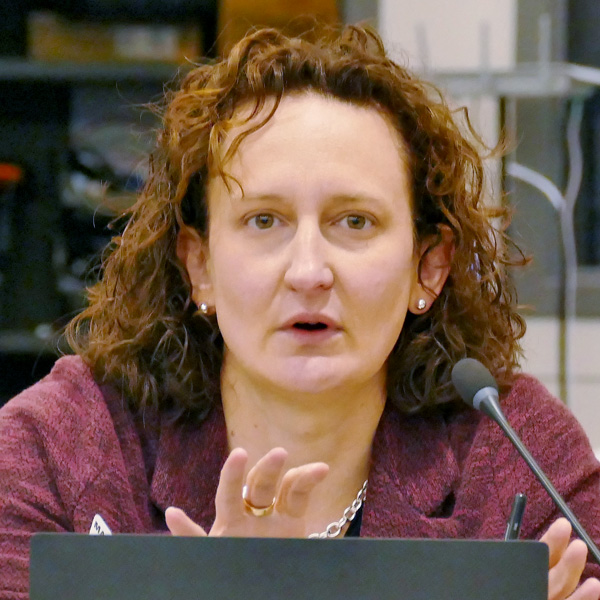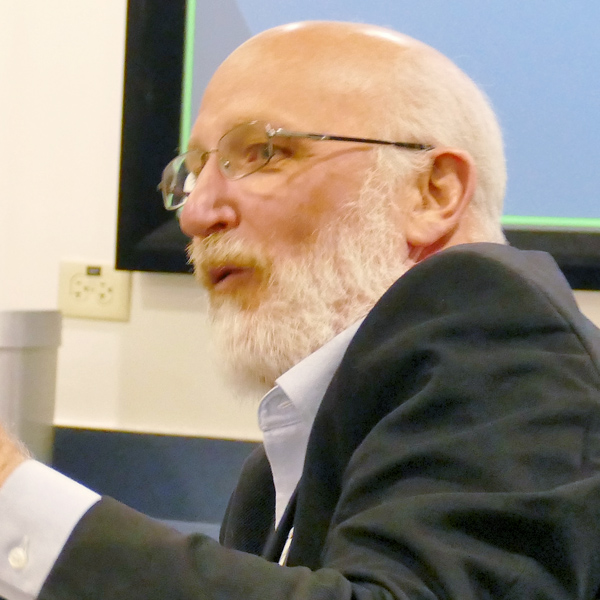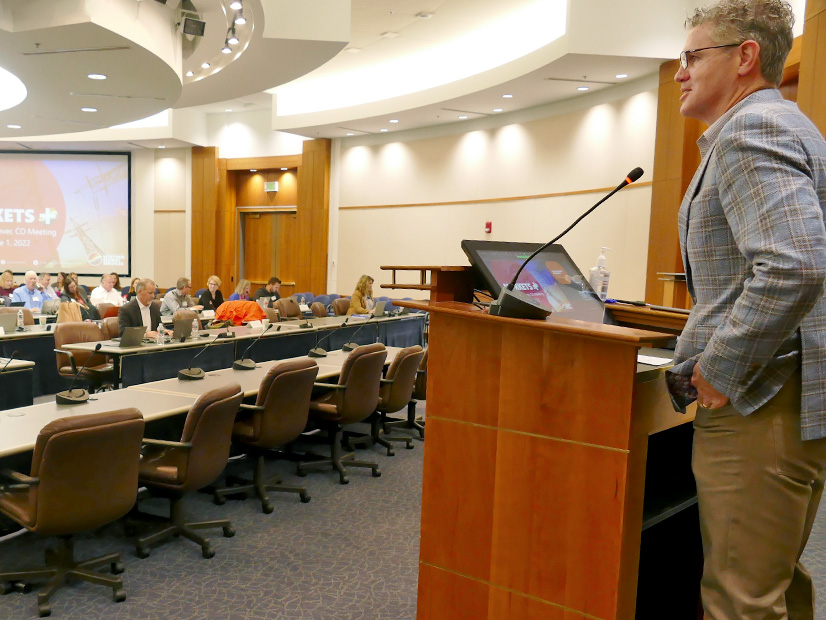WESTMINSTER, Colo. — SPP continued its delicate dance with Western Interconnection entities last week with a charm offensive that included a first-hand look at the RTO’s “sausage-making” process.
Promoted as a development session for Markets+, SPP’s “RTO light” offering, the two-day gathering at Tri-State Generation & Transmission’s headquarters gave the grid operator’s staff and Western stakeholders a chance to share their thoughts on a proposed governance model, transmission operations, congestion management and the benefits of RTO management.
Western utilities have long been wary of transferring control of their transmission facilities to RTOs, but SPP officials said they were pleased with the “healthy dialogue” and exchange of information. They also noted an increase in turnout from an earlier face-to-face session in Phoenix, with more than 100 in-person attendees and more than 80 participating virtually.
Another session will be held in Portland, Ore., in August.
Listening intently during the two days was Kathleen Staks, director of Western Freedom, a coalition representing large industrial customers in technology, oil and gas, mining, renewable energy, agriculture and other sectors. Staks took a guarded approach the discussion.
“We’re sort of tracking and compiling information and comments on behalf of our coalition … trying to kind of make sure that the customer voice is represented and incorporated into these efforts for whatever the end result is,” she told RTO Insider. “It’s about lower rates, it’s about access to clean energy, but it’s primarily an economic conversation in our coalition.”
Brad Hans, director of wholesale electric operations for SPP member Municipal Energy Agency of Nebraska — and also a member of MISO and WECC — was quick to share with others his company’s positive experience with SPP’s stakeholder process. He pointed out that the discussions taking place in Colorado were very similar to those of the RTO’s members during their stakeholder meetings.
“This is a true example of what SPP is all about, and that is members driving us. This whole meeting was about what they’ve done so far, and that is absolutely SPP’s stakeholder concept,” Hans said afterward. “I kind of wonder if they realize they’re in the midst of that right now … those that aren’t as familiar with SPP and, through this development process, in that culture as they develop this.”
AG Policy Solutions’ Alaine Ginocchio — “That’s Pinocchio with a G,” she said — consults with Western Resource Advocates, a public interest organization that was prominent during SPP’s attempt to integrate the Mountain West Transmission Group (See Xcel Leaving Mountain West; SPP Integration at Risk.) While she reluctantly uses the “sausage-making” expression, she appeared to like what she saw.
“We’re used to having sort of a higher level of stakeholder engagement and being engaged on more of an equal footing with everybody else,” she said. “The energy market they’re standing up right now … is structured more to have equal footing. Not as much as CAISO, but it’s a different program. Public interest organizations have more of a voice in voting and processes [in Markets+] … and that sort of flows out of how other regional coordination efforts have worked. That’s what we’re used to, and it has worked.”
Incremental Changes in the West
Those out West will say the Western energy crisis of 2000-01, when Enron’s market manipulation led to rolling blackouts in California, had a chilling effect on regional coordination and energy markets. SPP Director Mark Crisson, who spent nearly 30 years with Tacoma Public Utilities, said in April that “RTO paranoia” still hangs over the balkanized region and its 38 balancing authorities. (See SPP Strategic Planning Committee Briefs: April 13, 2022.)
“There’s a lot of concern about FERC regulation,” Crisson said during an SPP Strategic Planning Committee meeting. “A lot of people remember that exercise.”
Change has been incremental in the West since then. The region’s wide open spaces and political differences can make it difficult to coordinate regionally, but renewable standards, the success of Eastern markets, CAISO’s Western Energy Imbalance Market (WEIM), and legislation in Colorado and Nevada mandating that utilities join RTOs by 2030 have managed to bring the interconnection’s entities closer together.
 Xcel Energy’s Carrie Simpson explains her thinking on market design. | © RTO Insider LLC
Xcel Energy’s Carrie Simpson explains her thinking on market design. | © RTO Insider LLCThe Markets+ day-ahead market is another incremental step toward a Western RTO. It provides a “voluntary” opportunity to realize the benefits of centralized day-ahead and real-time unit commitment and dispatch, “hurdle-free” transmission service, and “reliable” integration of renewable generation for utilities that aren’t ready “to pursue full membership in” an RTO.
“We recognize that not everyone is at a point where they’re comfortable moving to an RTO, because they are transferring control of their facilities to the RTO,” SPP Senior Vice President of Operations Bruce Rew told the gathering. “We see Markets+ as a possible long-term solution to meeting some market needs.”
All of this is familiar to Xcel Energy’s Carrie Simpson, director of Western markets for Xcel’s Public Service Company of Colorado. Simpson joined Xcel in 2015 after helping design SPP’s Integrated Marketplace, which will serve as the foundation for Markets+.
“It’s a similar vibe,” she said before appearing on a resource adequacy panel.
Simpson has become something of a rock star in Western power circles for her market expertise. She was not present for the opening introductions, but Joe Taylor, manager of transmission access for Xcel Energy Services, made sure everyone knew she would eventually show up.
“Joe Taylor, Xcel Energy. And don’t worry, Carrie Simpson will be here in a few hours,” he said to laughs.
Governance Model a Key Issue
SPP has said Markets+ will eventually replace the Western Energy Imbalance Service (WEIS) market it currently operates. When three new members join the WEIS next year, it will be regionally balancing 13.5 GW of load generation. Rew said an imbalance market is a great introduction to markets but is only a short-term solution for participants.
“There are some limitations to Markets+,” Rew said. “You don’t have a regional tariff; you don’t have a consolidated balancing authority, so you’re not going to get all the benefits. It will provide a lot of potential outcomes for certain market participants that are uncomfortable moving to an RTO.”
SPP is attempting to ease that discomfort. It has hired two very familiar faces from the West in Steve Johnson, formerly senior vice president of the Colorado River Storage Project for the Western Area Power Administration, and Kara Fornstrom, former Wyoming Public Service Commission chair. Johnson is directing the RTO’s various markets’ administration and operation. As director of state regulatory policy, Fornstrom is leading state regulatory policy efforts in the West where she appears to be on a first-name basis with many participants.
 SPP’s Paul Suskie (right) explains the Markets+ governance model as Kara Fornstrom takes notes. | © RTO Insider LLC
SPP’s Paul Suskie (right) explains the Markets+ governance model as Kara Fornstrom takes notes. | © RTO Insider LLC
SPP executives also pointed out that two members of its board, Crisson and newly-elected John Cupparo, both have deep ties to the West. A Colorado State graduate, Cupparo was CEO of Berkshire Hathaway Energy’s transmission subsidiaries and also served in leadership roles at PacifiCorp, WECC and Northern Tier Transmission Group.
“Somebody made the comment [earlier], ‘Do I want a board member from Little Rock [Ark.] determining matters for the [Western] markets?’” SPP legal counsel Paul Suskie said. He took pains to note that only one SPP director (Oklahoma law professor Phyllis Bernard) has ever hailed from the footprint, and that she has since moved to Oregon. The other 16 directors since 2004 have come from outside the RTO’s service territory.
“So that gives you a taste of the board,” Suskie said. “They are truly independent.”
That is important, as the West’s most immediate experience with an organized market is that of CAISO, where the board is appointed by California’s governor.
Last week, SPP shared a straw man of its proposed Markets+ governance model, based on input from Western stakeholders and the grid operator’s best practices. The model is also designed to gain FERC approval and to minimize financial consequences for SPP, which will have to carry the debt necessary to stand up the market.
The model has an independent panel, comprised of one SPP director and four Western representatives elected by a forum of Markets+ participants and stakeholders, that would govern market operations and report to the RTO’s board. Suskie was asked why it’s called a panel and not a board. Simply to avoid confusion, he said.
The Markets+ Independent Panel (MIP) would oversee a Markets+ Participants Executive Committee (MPEC), which would be responsible for creating and managing the various stakeholder groups. A Markets+ State Committee would provide input from Western regulatory commissions to both the MIP and MPEC.
Market participants will be classified as either participants or stakeholders, depending on whether they contribute generation or load. They will sign either participant or stakeholder agreements, with stakeholders retaining voting rights in return for an annual $5,000 fee. Non-voting stakeholders could eschew the fee and provide input during stakeholder meetings, but they would not have voting rights.
The design is part of SPP’s key foundation of ensuring everyone can contribute to stakeholder discussions, Rew said.
“We are going to continue to foster engaging discussions on Markets+, making sure that we give voice to diverse perspectives,” he said. “Then, continuing to develop this vision for Markets+ until ultimately Markets+ is your market. It’s not just for the participants, but also the benefit it provides overall to the Western Interconnection.”
 Maury Galbraith, WIEB | © RTO Insider LLC
Maury Galbraith, WIEB | © RTO Insider LLCMaury Galbraith, executive director of the Western Interstate Energy Board, called the governance model “acceptable,” and alluded to a race between SPP and CAISO to establish a Western RTO.
“You get a lot of people saying that ‘This is not a race.’ People say, ‘No, it is a race. It is a competition; we need to move forward,’” Galbraith said. “I understand that time is important here. The governance proposal is something that is probably acceptable to a large number of states. I think the word ‘acceptable’ is right. I don’t see any showstoppers in there. I’m not aware of any state that is, sort of at the point where they’re ready to go to FERC and oppose anything.
“I think it’s a workable solution. But in terms of the overall competition and really striking a bold governance structure, I don’t see the proposal being a bold proposal. I think we could have gone farther in terms of really trying to win the governance battle, if that’s what it is. I think there’s some additional steps that could have been taken to really, really come up with a best-practice governance structure, and I’d be happy to have that conversation.”
Next Steps for Markets+
Galbraith’s comments were among several, some more pointed than others, from a panel during a breakout session on the proposed governance model. Suskie thanked those offering feedback. What they had just experienced, he said, was a best practice at the RTO.
“We like to call this an example of how SPP does things,” he said before drawing on his experience as an officer in the Army reserves during a stint in Afghanistan. “We put out a straw proposal, we put on our body armor, and we get shot at. We have our ideas, we take feedback, and then we can figure out how to adjust it. Part of the balance that we have is SPP has a lot of responsibilities. It’ll be SPP’s tariff and it will be SPP who will be operating this market and facilitating that.”
Suskie and Fornstrom took the comments and returned the next day with a revised timeline. An updated governance proposal will be shared during a June 24 webinar, with written comments due July 15. SPP will summarize the written comments in another webinar before the Portland workshop.
While governance took much of the spotlight, attendees also heard updates from the transmission availability and the market products/price formation design teams. Western stakeholders briefed the room on greenhouse gas tracking and a panel of market monitors — SPP Market Monitoring Unit Vice President Keith Collins; Libertas Market Analysis’ Jeff McDonald, formerly ISO-NE’s Monitor; and Potomac Economics’ David Patton (virtually) — shared their thoughts on internal, external and hybrid monitoring structures.
Western Power Pool (WPP) CEO Sarah Edmonds, just months into her new position, appeared virtually to describe the potential relationship between Markets+ and the pool’s Western Resource Adequacy Program (WRAP), which SPP already administers in partnership with WPP. Assuming FERC’s approval of WPP’s tariff, the WRAP is scheduled to go live early next year, with members demonstrating they have procured the required quantity of credited capacity from physical resources. In return, they get priority access to WRAP’s supply.
“We have a lot of success in the region brokering consensus on a workable package around governance. A lot of the elements that have been addressed in governance for Markets+ are common to WRAP or even originated from WRAP … trying to solve some of the hardest problems in the West based around governance,” Edmonds said.
“This is still an incremental program that’s singularly focused on resource adequacy and not a market. It is not an RTO but it is a workable framework and one that we’ve always said from the very beginning would be compatible with a market … and here we are in a conversation with the West with a couple of options on the table,” she said. “[Resource adequacy] is a very important foundation for healthy well-functioning markets, and I think WRAP can serve that purpose for Markets+.”
SPP plans to have draft service offerings available for comment by the end of September. Participants will be able to agree to financially binding commitments in the first quarter of 2023, at which point they can develop the market protocols and tariff language.




